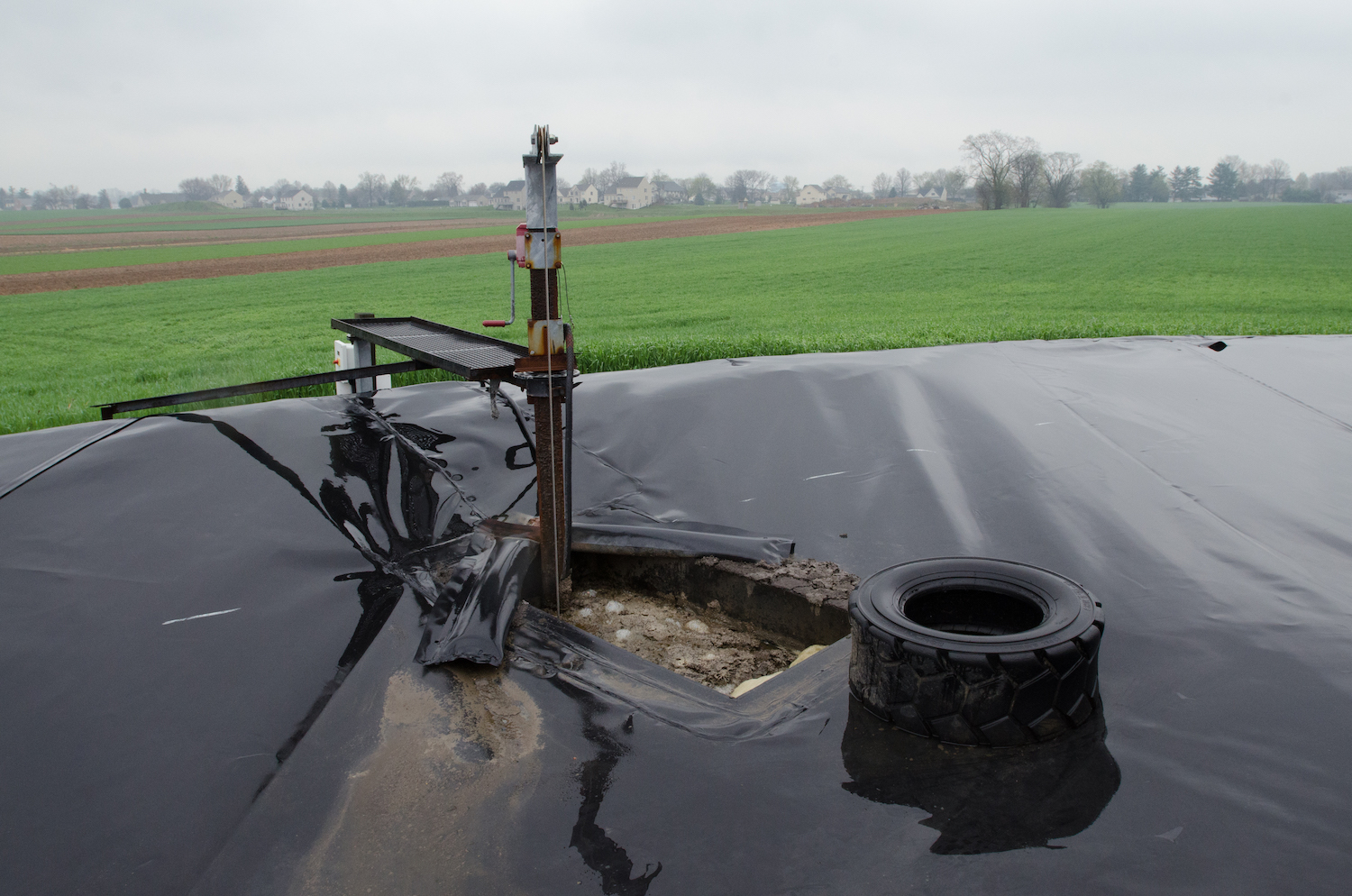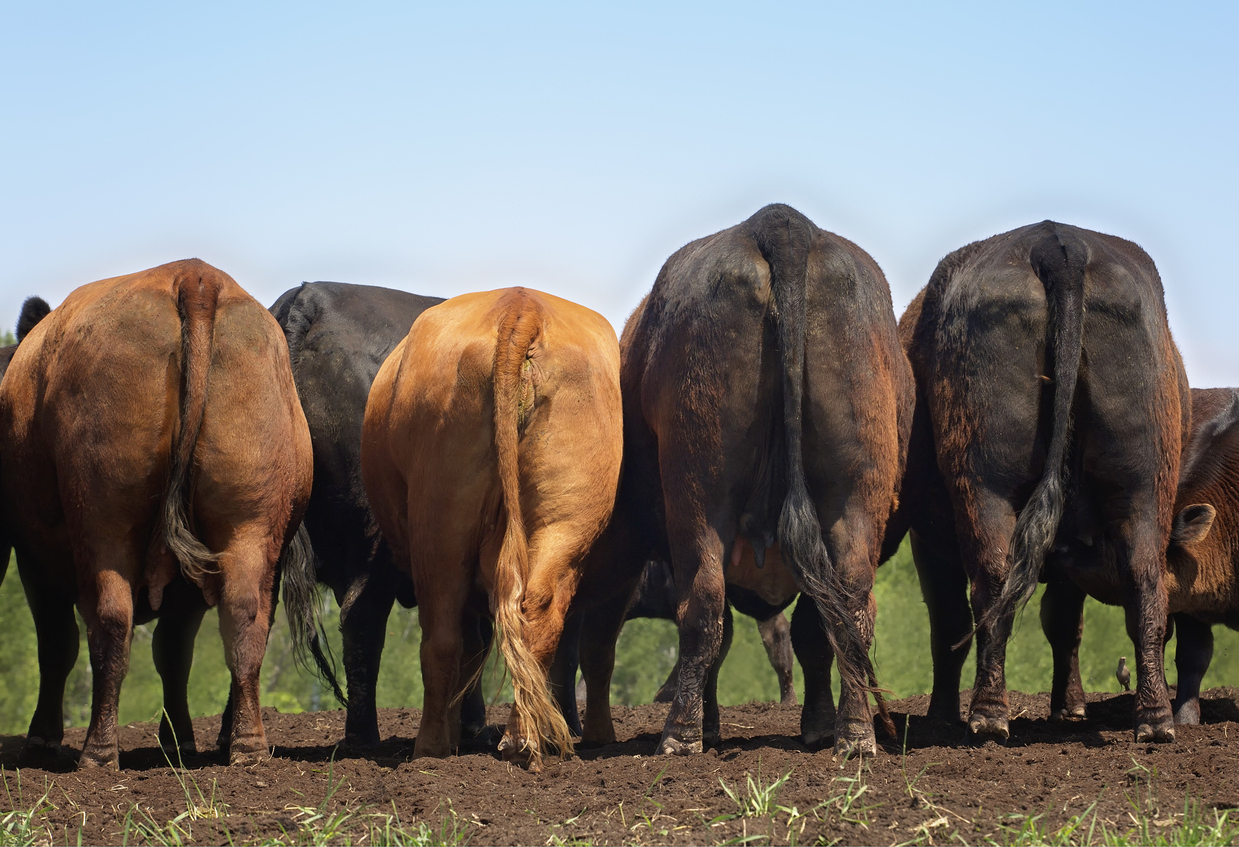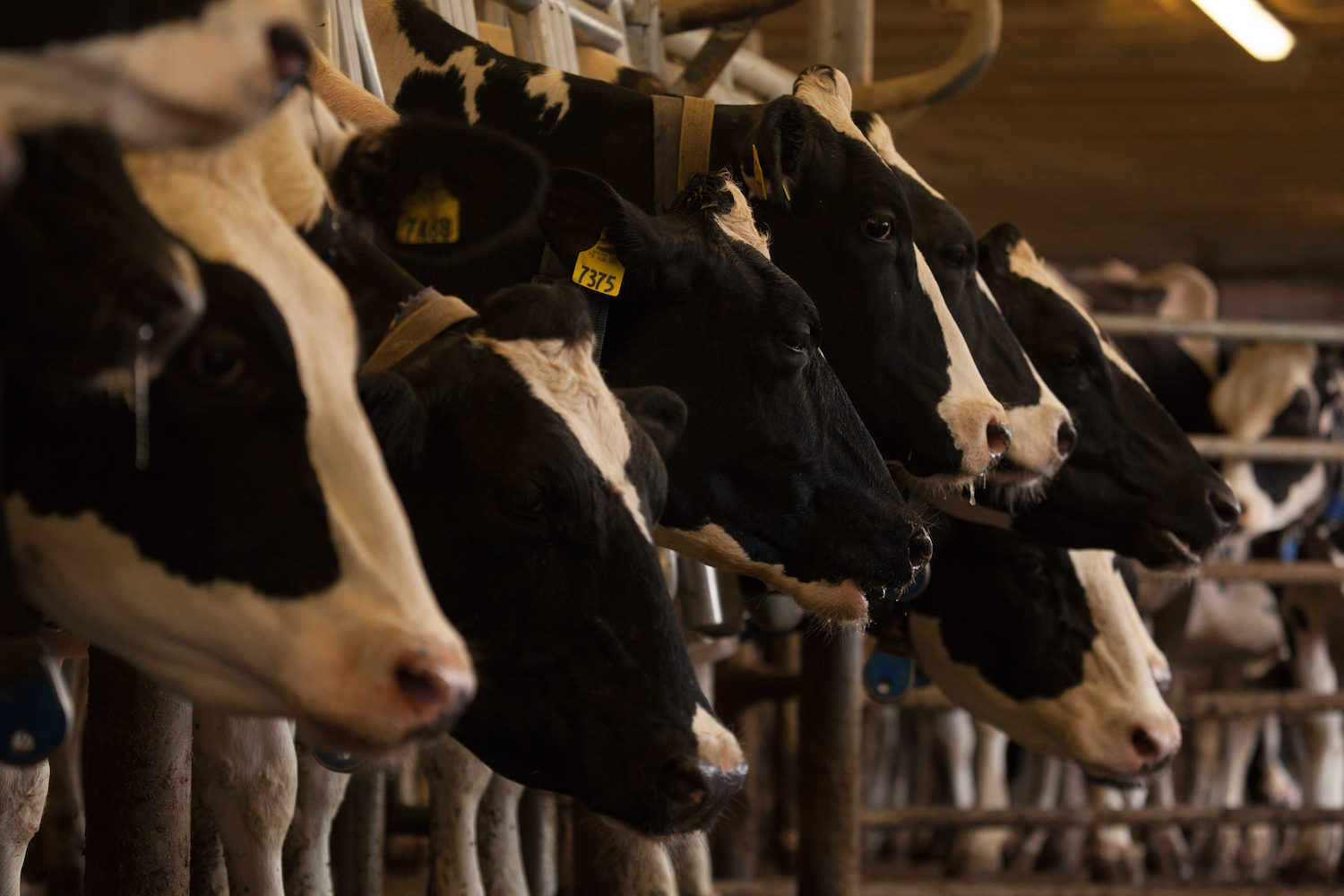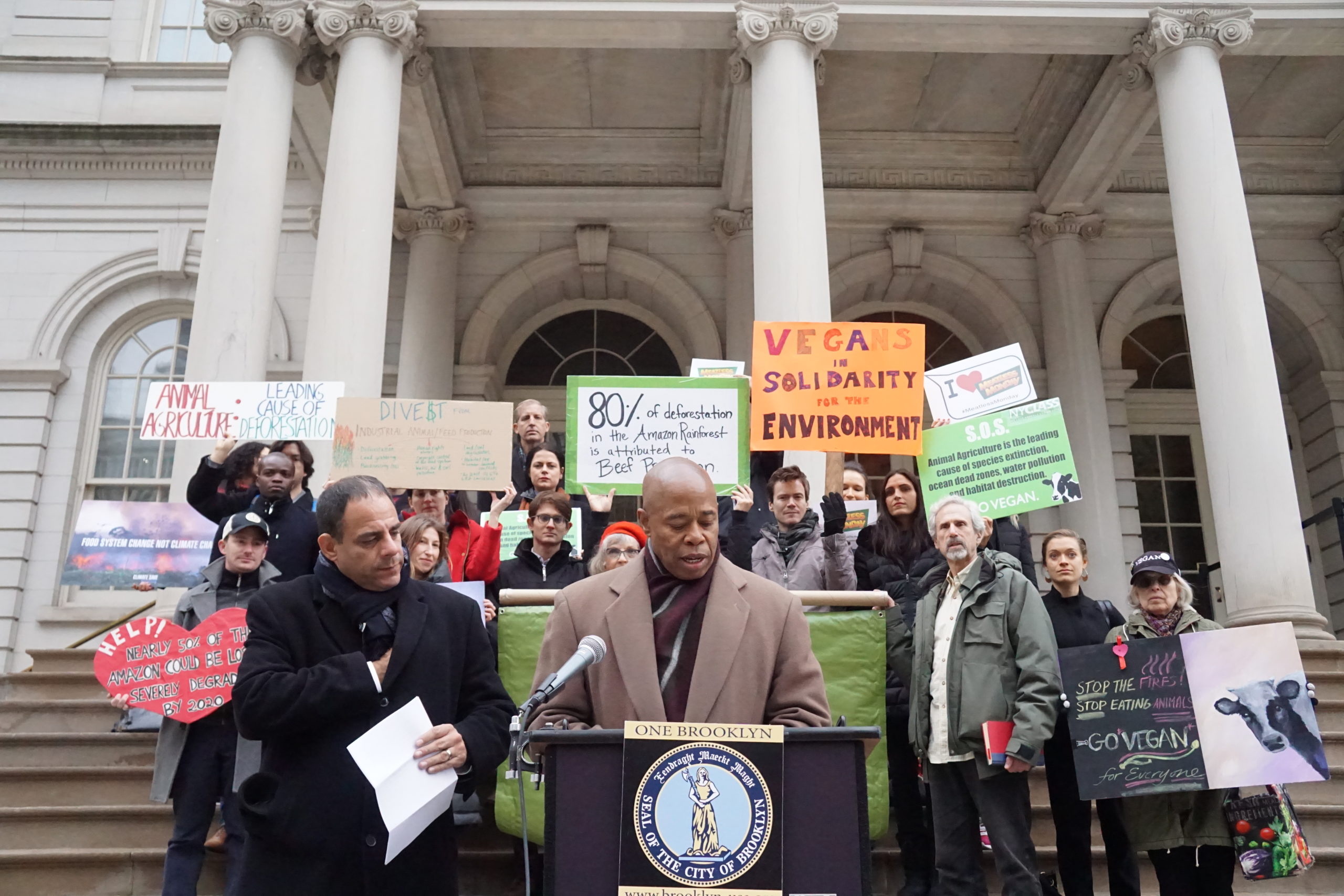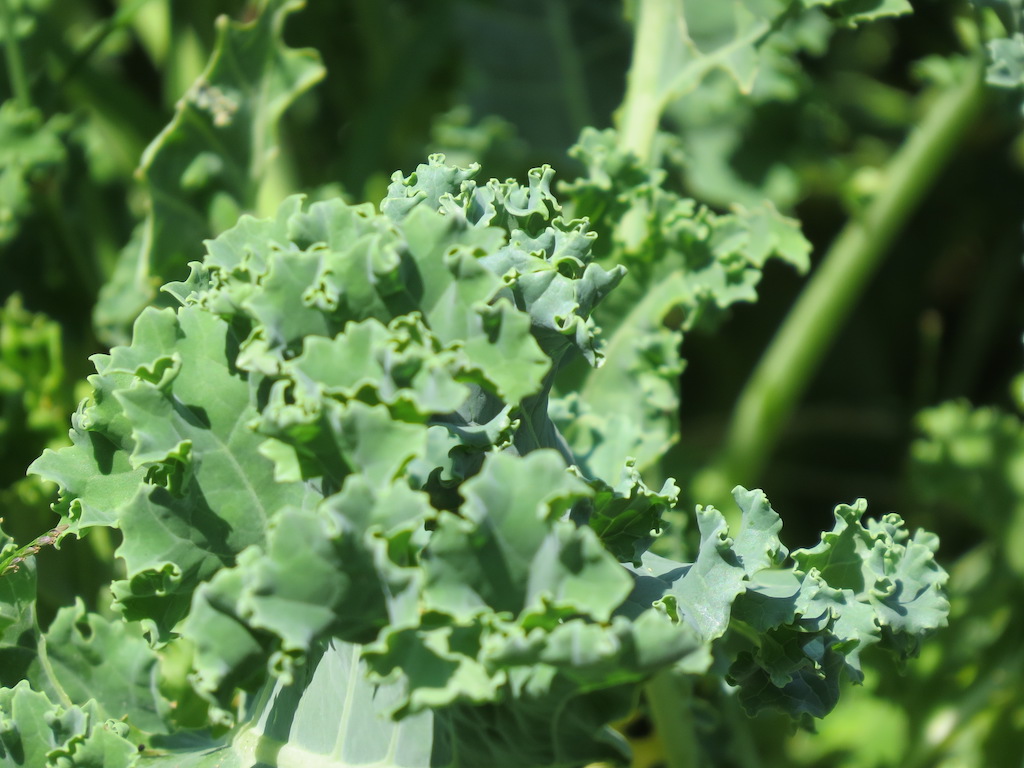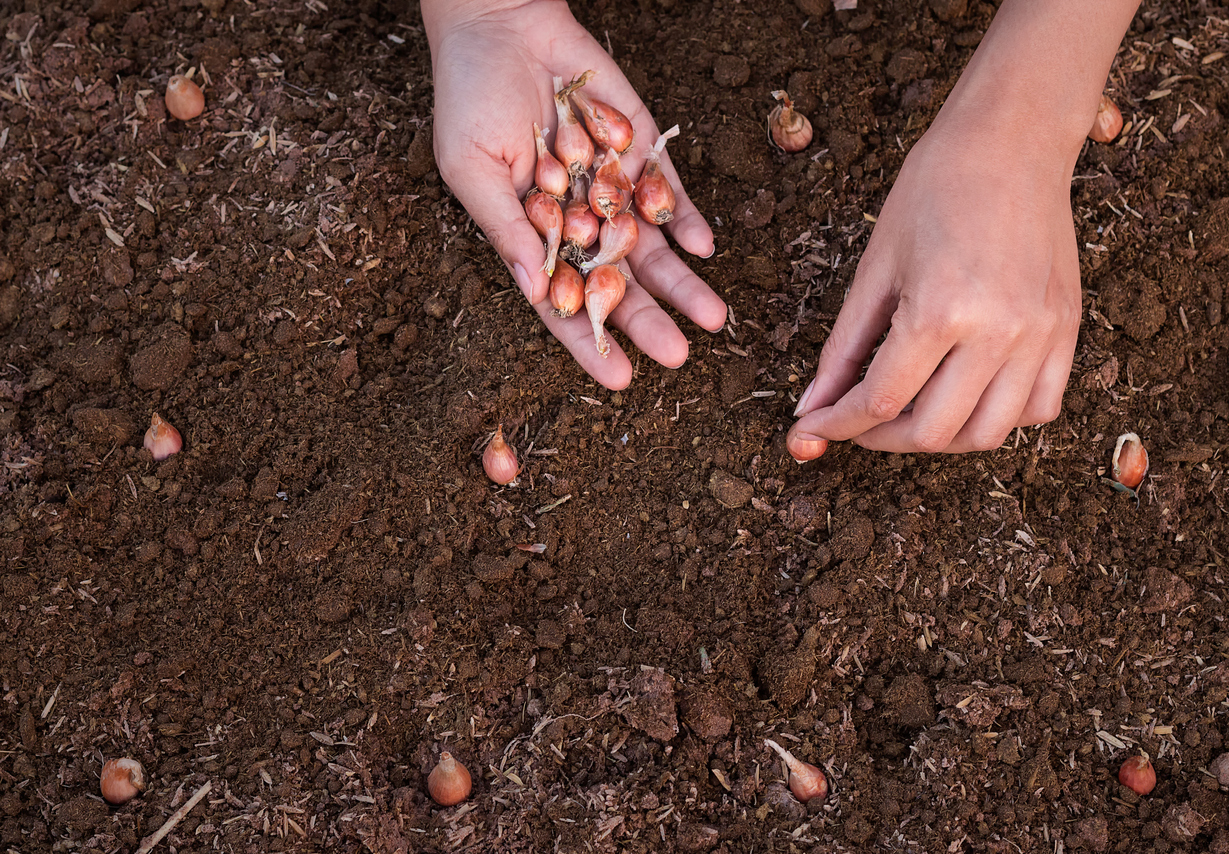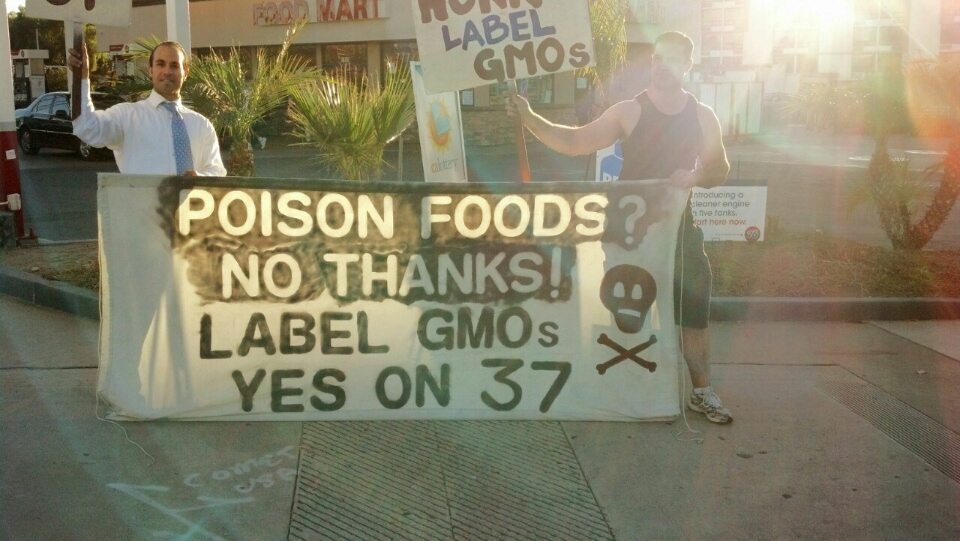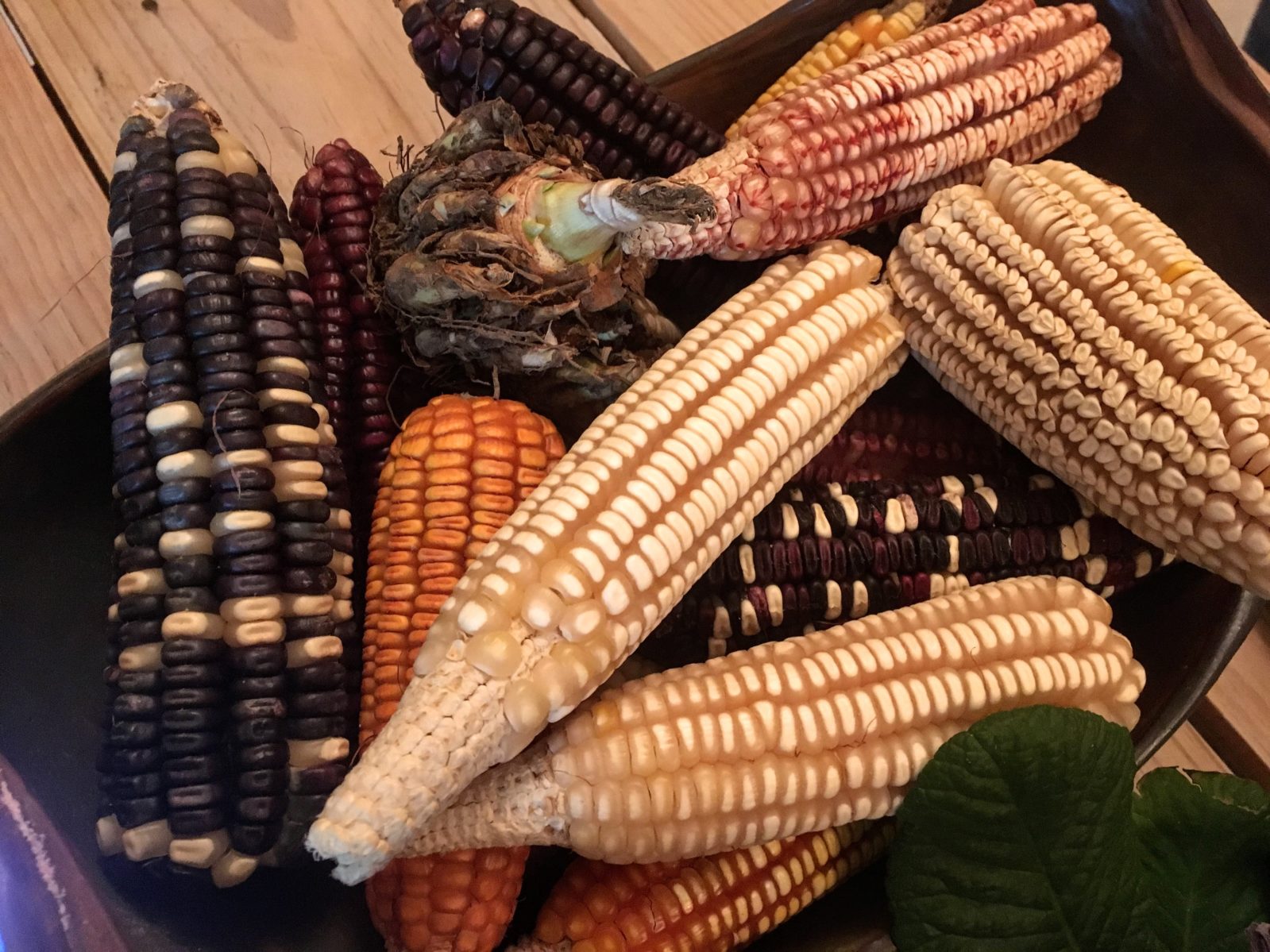Federal agencies and state governments are spending millions on anaerobic digesters to wring renewable energy from animal poop. But critics say “cow power” from factory farms is neither clean nor green.
At a glance, anaerobic digesters seem like the perfect solution to one of society’s many messes: They take the waste from cows, pigs, and chickens raised en masse for human consumption, and from literal shit generate energy to power our cars, homes, and electronics. What could be more renewable than manure?
To that end, last year, the New York State Energy Research and Development Authority (NYSERDA) announced $16 million in funding for new and existing on-farm anaerobic digesters, an additional windfall for a sector that has already received more than $26 million from the agency. It’s a big investment, but NYSERDA is just one government agency bankrolling the digester industry: A database of renewable energy policies and programs across the country lists 96 financial incentives for anaerobic digesters, including property tax reductions, corporate tax credits, loan programs, grant programs, and performance-based incentives.
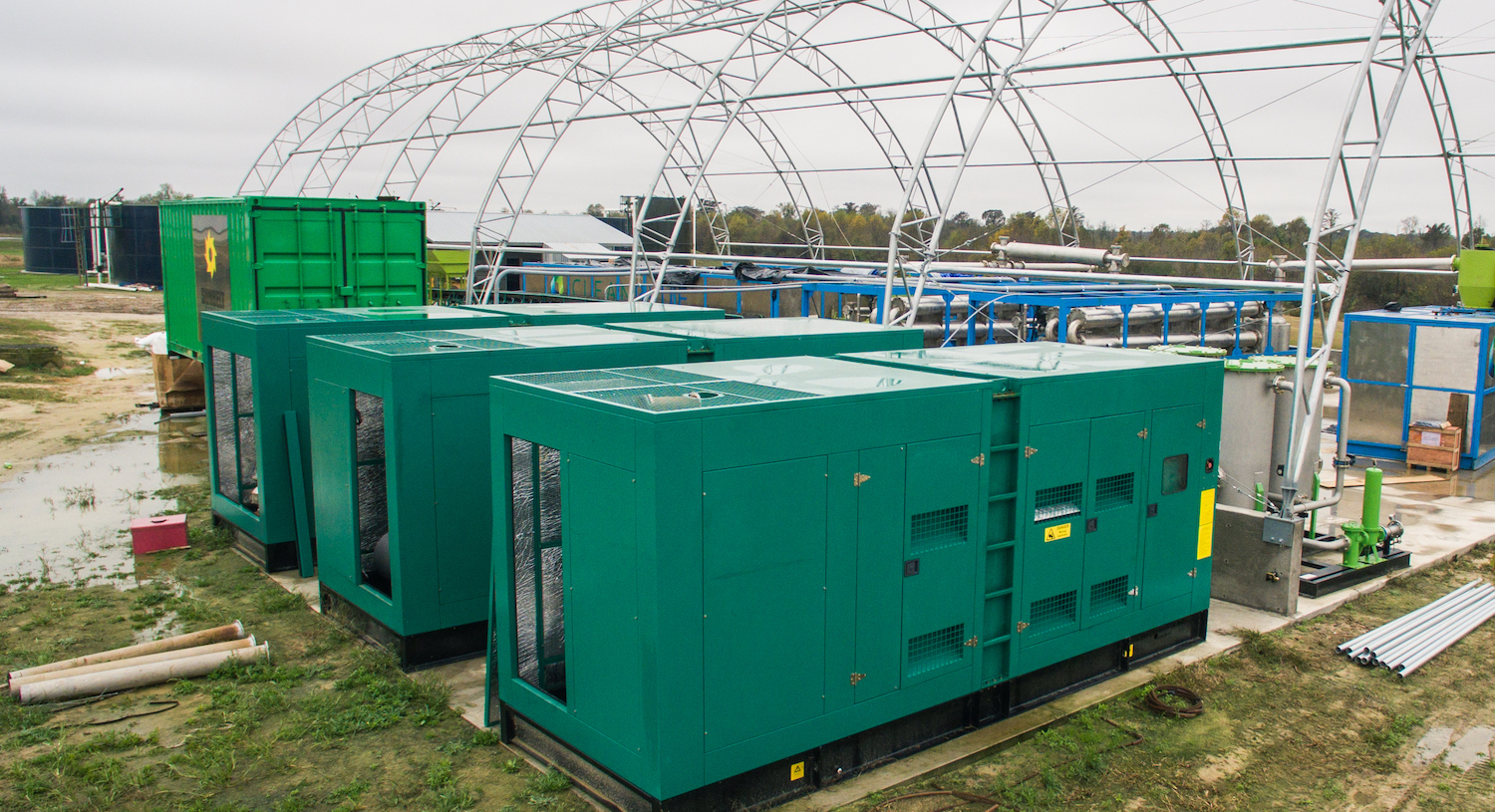
Because methane is calculated to be 25 times more potent a greenhouse gas than carbon dioxide, burning it for fuel and releasing carbon dioxide is still considered to be a greenhouse gas reduction
The thing is, digesters are expensive: expensive to build, expensive to maintain. They can sometimes generate enough energy to power an entire farm, reducing one big bill and offsetting the cost of the digester, but the excess energy isn’t usually so excessive that selling it back to the grid nets the farm significant profits. Without outside funding, it simply doesn’t make financial sense for most farms to build or operate a digester. The question is, do the environmental benefits justify significant—and ongoing—public investment?
Critics say absolutely not. While biogas from digesters may be renewable, it is hardly “clean” or “green” in the way most people understand those concepts. The biogas produced through anaerobic digestion is a mix of methane, carbon dioxide, and other trace gases. Burning biogas for energy converts methane into carbon dioxide, and also produces carbon monoxide, nitrogen oxides, sulfur dioxide, and other hazardous air pollutants. The carbon dioxide generated during anaerobic digestion and during the combustion of methane is released into the atmosphere.
The only reason that anaerobic digesters can be considered a “green” technology is because methane is calculated to be 25 times more potent a greenhouse gas than carbon dioxide, so burning it for fuel and releasing carbon dioxide into the atmosphere instead is still considered to be a greenhouse gas “reduction.”
Manure releases methane only when it decomposes in oxygen-free (anaerobic) conditions, like a pit or lagoon.
But are digesters even necessary? Around 80 percent of digesters in the U.S. are on dairy farms, but methane emissions from manure deposited on fields from pastured cows are virtually nil. Manure releases methane only when it decomposes in oxygen-free (anaerobic) conditions, like a pit or lagoon. Most of the livestock farms that store manure in pits or lagoons are large concentrated animal feeding operations (CAFOs) where animals are confined for more than 45 days of the year. So, critics say, anaerobic digesters are solving problems only created by large-scale factory farming in the first place, problems that are avoided in more sustainable systems, especially pasture-based ones.
This purportedly green technology has divided environmentalists into two camps: The first, which includes organizations like the World Wildlife Fund and the Environmental Defense Fund, are those who think that anaerobic digesters make the best of a bad, but inevitable, situation. The second group, which includes Food & Water Watch, says the government is greenwashing and subsidizing factory farming at the expense of sustainable producers and genuinely clean, renewable energy like wind and solar.
***
Every day, a 1,400-pound dairy cow will generate about 120 pounds or 14 gallons of feces and urine. At larger dairies, that can really add up. Take Fair Oaks Farms in Indiana, for example, home to 38,000 dairy cows. One of Fair Oaks’ on-site digesters takes in 650,000 gallons of manure from 15,000 cows every day—and that is less than half of the manure the farm produces. It is an almost unfathomable amount of cow crap. Without a digester, disposing of it all is tricky, and the more you have, the harder it is.
There are two options for most farms—spreading and storing, or some combination of the two. Daily spreading is exactly what it sounds like: Collecting the manure, loading it into a mechanized spreader, driving out, and spraying it on cropland and pasture. Manure is rich in essential soil nutrients—nitrogen, phosphorus, and potassium—so it can be a good fertilizer, and as long as the spreading is done quickly, it emits very little methane. However, daily spreading has some downsides, especially if one has to spread when conditions are poor: Spreading on saturated ground can compact and degrade the soil, and spreading too heavily or in the winter when the ground is frozen can result in manure run-off. While nitrogen, phosphorous, and potassium can be beneficial for cropland, excessive amounts in streams, rivers, and lakes can cause toxic algal blooms and hypoxia, leading to aquatic “dead zones” where marine life can’t survive.
The alternative to spreading is to indefinitely store the manure until it can either be spread on the ground or hauled away. Smaller farms might stockpile dry manure under a tarp or in a three-sided structure with an impervious floor, to prevent the manure from contaminating the water table, or they might compost it with straw and other organic waste.
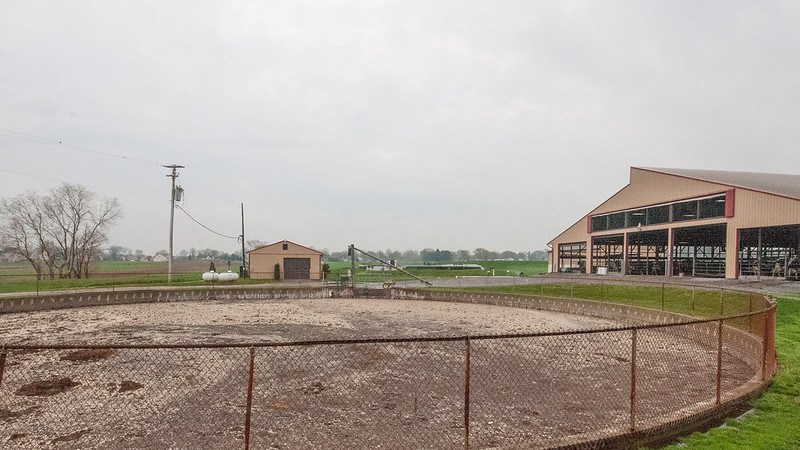
Giant swimming pools of liquid manure are oxygen-free environments, and manure stored in them releases methane, carbon dioxide, and other noxious gases that can be fatal
Larger farms are more likely to build giant pits or lagoons to store liquid manure. Like digesters, these giant swimming pools of liquid manure are oxygen-free environments, and manure stored in them releases methane, carbon dioxide, and other noxious gases that can be fatal to humans and animals. They are also vulnerable to structural failures and extreme weather events, which can cause storage pits to overflow or leak.
After Hurricane Florence in 2018, millions of gallons of hog manure flooded North Carolina. In 2013 alone, Wisconsin farms spilled more than one million gallons of manure. These accidents pollute the environment with nitrogen, phosphorous, and potassium, but raw manure can also contain hormones, antibiotics, and bacteria like E. coli. And then there’s the smell.
Anaerobic digesters were supposed to help with all that.
***
With only 400 cows, Wagner Farms is an unusually small dairy to have an on-site anaerobic digester, and the smallest in New York to own and operate one. Less than 15 miles from Albany, the surrounding area is surprisingly suburban, with single-family homes set into neatly trimmed lawns.
Keith Wagner, the farm’s anaerobic digester operator, says their location restricts how much the third-generation family farm can grow: Fields are smaller and harder to come by near Albany than they are in the western part of the state. That was one reason Wagner Farms invested in an anaerobic digester a decade ago.

“The idea was, instead of growing larger, you know, we wanted to grow vertically instead of horizontally,” Wagner says, although the payoff hasn’t been as high as they hoped. Wagner would like to see New York institute something like Vermont’s Cow Power program, which pays farmers for the energy generated, plus an additional four-cents per kilowatt-hour “for the environmental benefits.”
Even just 400 cows produce a lot of manure. It’s collected in an enormous vat housed in an outbuilding with red siding and a sloped roof. The manure is scraped directly from the surrounding barns into the pit with a skidsteer, which is kind of like a snow plow, but used here for cow poop; the rest is hauled in with a dump truck and unloaded “right here where we’re standing.”
At our feet is a semi-circular hole at least eight feet wide, with an open metal flap like a giant’s toilet seat cover. The lid, rim, and floor are splattered with dark brown muck, and the adjacent walls are caked up to the ceiling. Inside the pit, a grayish, greenish-brown soup swirls, moved by submerged blades. The pit beneath our feet can hold 12,000 gallons of manure and Wagner says they get about that much every day. Periodically, unseen pipes empty their contents into the cauldron with a splash. A giant bubble of gas rises to the surface and bursts, thickly. The stench is momentarily overwhelming.
Interest in anaerobic digesters in the United States first peaked during the fuel shortages of the 1970s.
The shit slurry in front of me is the first step to converting manure into biogas through anaerobic digestion. Once in the pit, propellers agitate the manure so that it isn’t too clumpy or thick to pump. Wagner Farms sometimes adds food scraps to the mix, which both increases the amount of biogas produced and brings additional income to the farm in the form of “tipping fees,” or payment from towns or companies for disposing of food waste. The manure is pumped into the digester twice an hour, Wagner says, five to eight minutes at a time. The digester itself can hold up to 265,000 gallons of manure.
Inside the digester it’s basically like “one giant heated swimming pool,” says Wagner.
Bacteria eat the organic matter in the manure, producing methane, carbon dioxide, and trace amounts of ammonia and hydrogen sulfide. Those gases rise to the ceiling of the soft-top digester. The biogas is then piped from the digester to a generator that produces the electricity that powers the farm; any excess electricity is traded back to the grid through remote net metering and the Wagners get a credit on their next electricity bill.
The remaining effluent from the digester is separated into solids and liquids: The solid digestate is like fibrous compost, dry and fluffy to the touch when I crumbled a handful between my fingers. It smells earthy, but not unpleasantly so. Wagner Farms uses this as bedding for their cows. The liquid digestate flows into a pit lagoon to be later spread over the 1,000 acres on which Wagner Farms grows forage crops.
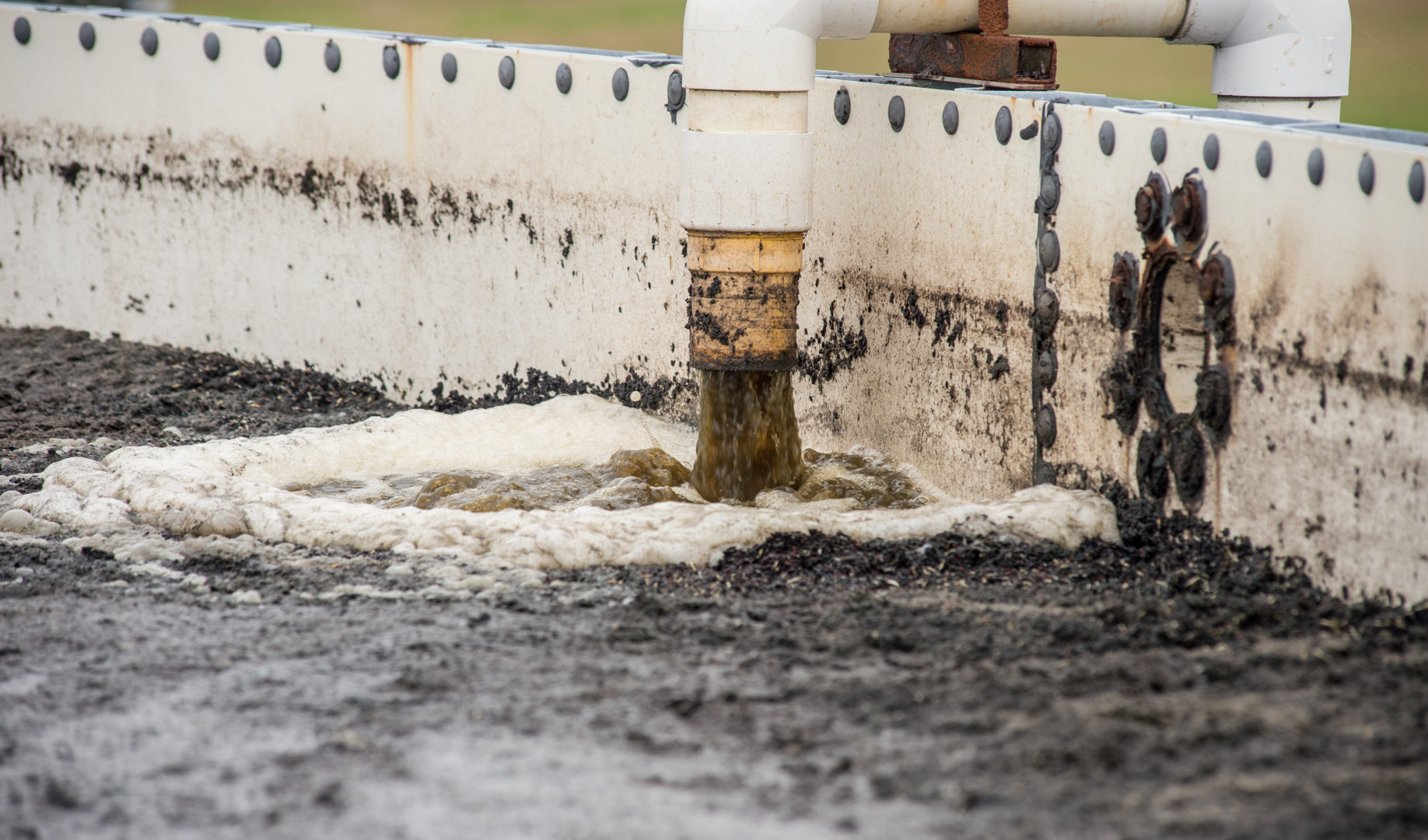
A database of renewable energy policies and programs across the country lists 96 financial incentives for anaerobic digesters
Sometimes, the digester produces more biogas than the generator can handle. When I visited, excess methane from the digester was being regularly flared off—burned, but not for energy—so that the digester wouldn’t explode from being too pressurized. Essentially it was like watching money and energy disappear into the wind—greenhouse gas emissions with no benefit to Wagner Farms, or the energy grid. When asked how much methane is flared off, Wagner said he didn’t know because there wasn’t an incentive to monitor that.
***
Investment in anaerobic digesters in the United States first peaked during the energy crisis of the 1970s, when fuel shortages prompted many Americans to start thinking about energy alternatives. But enthusiasm waned in the ‘80s for several reasons: The price of oil dropped, digesters had a high rate of failure, and they became prohibitively expensive to fix and maintain. Around 85 percent of anaerobic digesters shut down, and by 1994 there were only 25 operating in the country.
Interest ticked back up again in the late 1990s, in part because of a growing awareness of the greenhouse effect and in part because communities near livestock farms were demanding something be done about the smell. A significant boost came during the Obama administration, when then-Secretary of Agriculture Tom Vilsack announced that U.S. dairy farmers would cut greenhouse gas emissions by 25 percent. But some advocates for family-owned and operated farms had a problem with how Vilsack planned to achieve that.
To understand their frustration, it’s important to note that the past few decades have been especially difficult for small dairies, and many have been forced to shutter. The number of dairy farms in the United States has steadily fallen over the past half century, from 648,000 in 1970 to just 75,000 in 2006. In 2018, more than 2,700 dairy farms closed, bringing the total number of dairies in the country to just 37,468. But this drastic contraction has not affected all dairies equally: Between 2000 and 2006, the number of farms with 30 to 200 cows fell by 30 percent; in that same time period, the number of farms with at least 2,000 cows more than doubled.
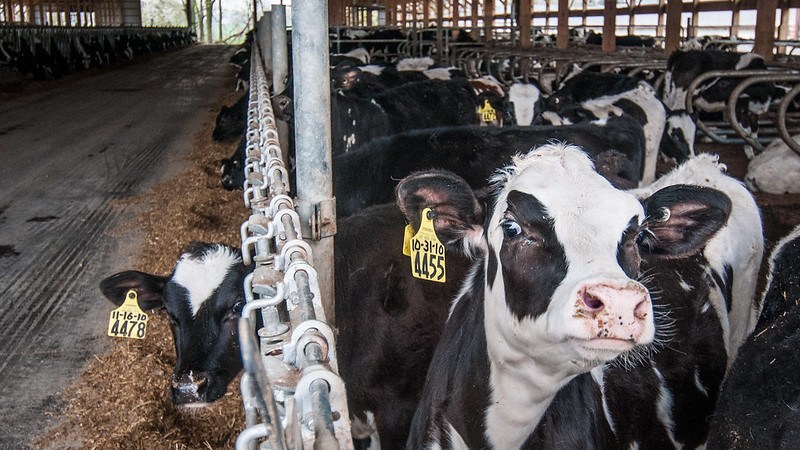
One of Fair Oaks’ on-site digesters takes in 650,000 gallons of manure from 15,000 cows every day—and that is less than half of the manure the farm produces
At the same time, greenhouse gas emissions from the agricultural sector have increased by 8.8 percent since 1990, and the primary driver of that increase has been manure management. The Environmental Protection Agency (EPA) cites a 57.1 percent increase in combined methane and nitrous oxide emissions from livestock manure management systems.
Greenhouse gas emissions have increased largely because of farm consolidation, because farms over a certain size have virtually no other choice but to store liquid manure, which emits more greenhouse gas emissions than other manure management systems. When the Obama administration announced that they would reward those mega-dairies with lavish grants for anaerobic digesters, it irked the small farmers raising dairy herds in environmentally sustainable ways. As Paris Reidhead reported in 2010 for The Milkweed, a dairy news publication, the $20 million in funding for digesters was made available only for farms with at least 1,000 animal units; an animal unit is 1,000 pounds of animal flesh, or about 700 dairy cows.
“I was in Copenhagen at the event where Vilsack was promoting manure digesters as a solution to greenhouse gas emissions,” says John Peck, the executive director of Family Farm Defenders, a nonprofit organization in Wisconsin. “He admitted then that only 10 percent of U.S. farms will qualify.”
“It’s like a classic problem. We’re going to subsidize the worst actors to clean up their mess.”
Curt Gooch, senior extension associate at the Cornell PRO-DAIRY program—which has a contract with NYSERDA to provide support to the digester industry—thinks it’s entirely natural for government agencies to fund anaerobic digesters only on the biggest farms. “We know the economics of digesters will basically never work on a 500-cow dairy in New York,” he said. “So why would we put them on a 50-cow dairy?”
An alternative would be to put in place environmental regulations that compel agricultural producers with high greenhouse gas emissions to fund their own manure management solutions. Instead, the government forks over millions earmarked for addressing environmental problems to the very farms that create and profit from the pollution in the first place.
“It’s like a classic problem,” says Peck. “We’re going to subsidize the worst actors to clean up their mess.”
Bankrolling the worst actors with public money has, in at least one notable case in Wisconsin, backfired spectacularly. In 2010, Dane County contributed $3.3 million for the construction of an anaerobic digester to combat manure pollution in the local watershed and regional lakes. The digester failed again and again.
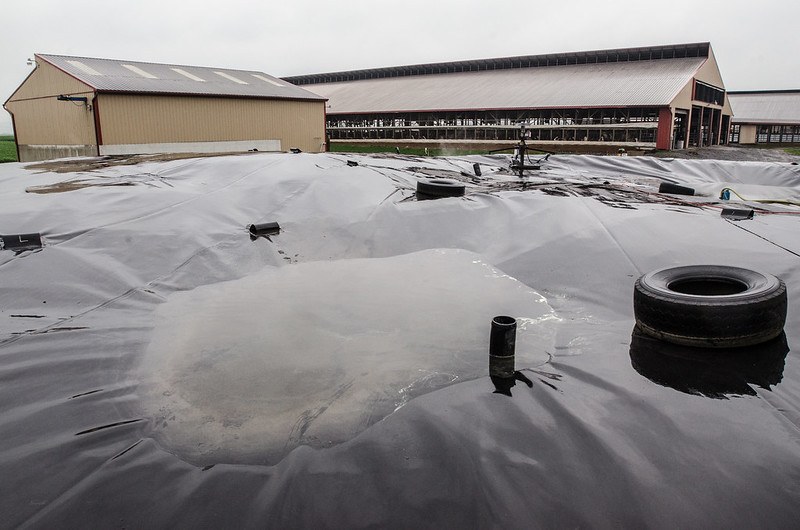
Critics argue the government is incentivizing the dairy industry’s worst actors to continue with business as usual
As Jim Eichstadt reported in a 2015 issue of The Milkweed, in a five-month period in late 2013 and early 2014, there were three separate liquid manure spills totaling 435,000 gallons. In 2014, a fire and explosion blew the cover off one of the digesters, rendering it inoperable. On top of that, there were “numerous” air quality violations, Eichstadt wrote.
But even if all goes as planned with a digester, there are still likely to be negative environmental impacts from large operations. And it’s not just greenhouse gas emissions: Water pollution from manure management is also a huge issue. Nutrients like phosphorus don’t simply disappear in the digester, Peck points out.
Phosphorus pollution is a serious and growing problem, and contributes to those nasty algal blooms that can kill fish and other aquatic life, according to a 2018 study in Water Resources Research, a journal of the American Geophysical Union. And it’s not the only potential pollutant still present in digester effluent.
“A growing body of evidence has suggested that currently available and feasible agricultural technology and practices cannot be expected to eliminate discharges into groundwater from dairies.”
“The nitrogen that is in the manure to start with doesn’t magically go away in the digester,” says Brent Newell, Food Project Senior Attorney at Public Justice. “It’s either going to go up in the air as ammonia, or it’s going to be on the ground as, you know, excess nitrogen. It’s going to pollute groundwater.”
A monitoring report prepared for the Central Valley Regional Water Quality Control Board in California found alarming “groundwater impacts” from confined animal facilities throughout the region, essentially everywhere they looked. Many of these facilities used anaerobic digesters to deal with their waste. The report came to a sobering conclusion:
“A growing body of evidence has suggested that currently available and feasible agricultural technology and practices cannot be expected to eliminate discharges into groundwater from dairies, nor alter volume or character of those discharges so that they are at or below some applicable water quality objectives. Likewise, currently available and feasible technologies and practices are not expected to result in returning groundwater quality to drinking water standards in many aquifers.”
***
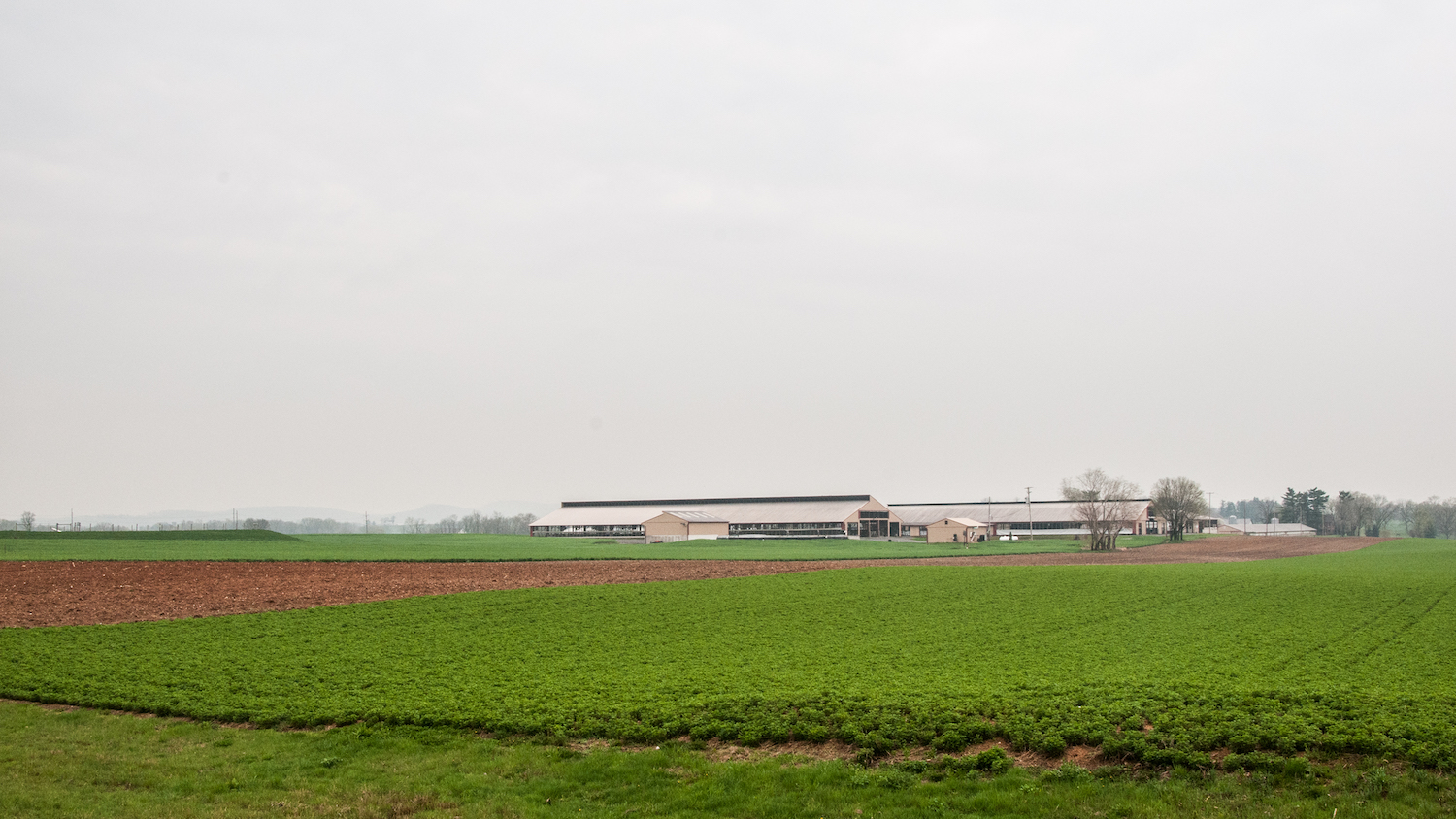
Manure is rich in essential soil nutrients, and as long as the spreading is done quickly, it emits very little methane
Breese Hollow Dairy is 30 miles from Wagner Farms in Hoosick Falls, New York, a few miles shy of the Vermont border. The foothills of the Green Mountains frame a picturesque vision of 60 Jersey cows at pasture. The scene could have been ripped from a milk carton.
Chuck Phippen used to work on aircraft engines at Pratt & Whitney in Connecticut, but he wanted to be a grass-based dairy farmer, so 25 years ago he and his wife bought some land in Ilion, New York. When they moved the farm to Hoosick Falls 16 years ago, the 170 acres were half corn and half alfalfa. They converted everything that had been corn to a pasture mix: perennial ryegrass, orchard grass, and red clover.
Twice a day, Phippen brings the cows in to be milked, and then lets them back out to pasture. He does rotational grazing, meaning he’ll fence off part of the pasture for the cows and after a while move them to a different part of the pasture, so that the grass in the first area has time to recover and regrow.
Federal and state subsidies are creating perverse incentives for more and bigger factory farms.
Manure isn’t a problem in Breese Hollow. The cows go where they go. If they happen to be in the holding area, waiting to be milked, the manure is shoveled outside. There was a modest heap by a tractor, no more than knee high, waiting to be spread on the fields. Manure deposited at pasture emits negligible amounts of methane, and there is a growing body of research that responsibly grazing cows can help sequester carbon.
When the environmental benefits of anaerobic digesters are calculated, they are generally compared to the environmental costs of keeping manure in long-term storage, something that happens only on large farms with confined animals. They aren’t generally compared to the kind of grass-based system that Phippen practices. Pasture-based systems can be harder to scale, but farmers also get a premium price for milk from grass-fed cattle that can help make up for that.
Phippen points out that there are other environmental costs to keeping animals permanently confined, and these aren’t always accounted for when adding up the benefits of anaerobic digesters: You need to bring in grain that was grown far away in vast, unsustainable monocultures, so there is the financial and environmental toll of growing the feed and hauling it in by truck. Cows kept in confinement need more antibiotics to keep from getting sick, and chemicals to stave off hoof-rot from standing on concrete all day, every day. And then of course, if you need to build a digester to handle manure, that’s expensive, too.
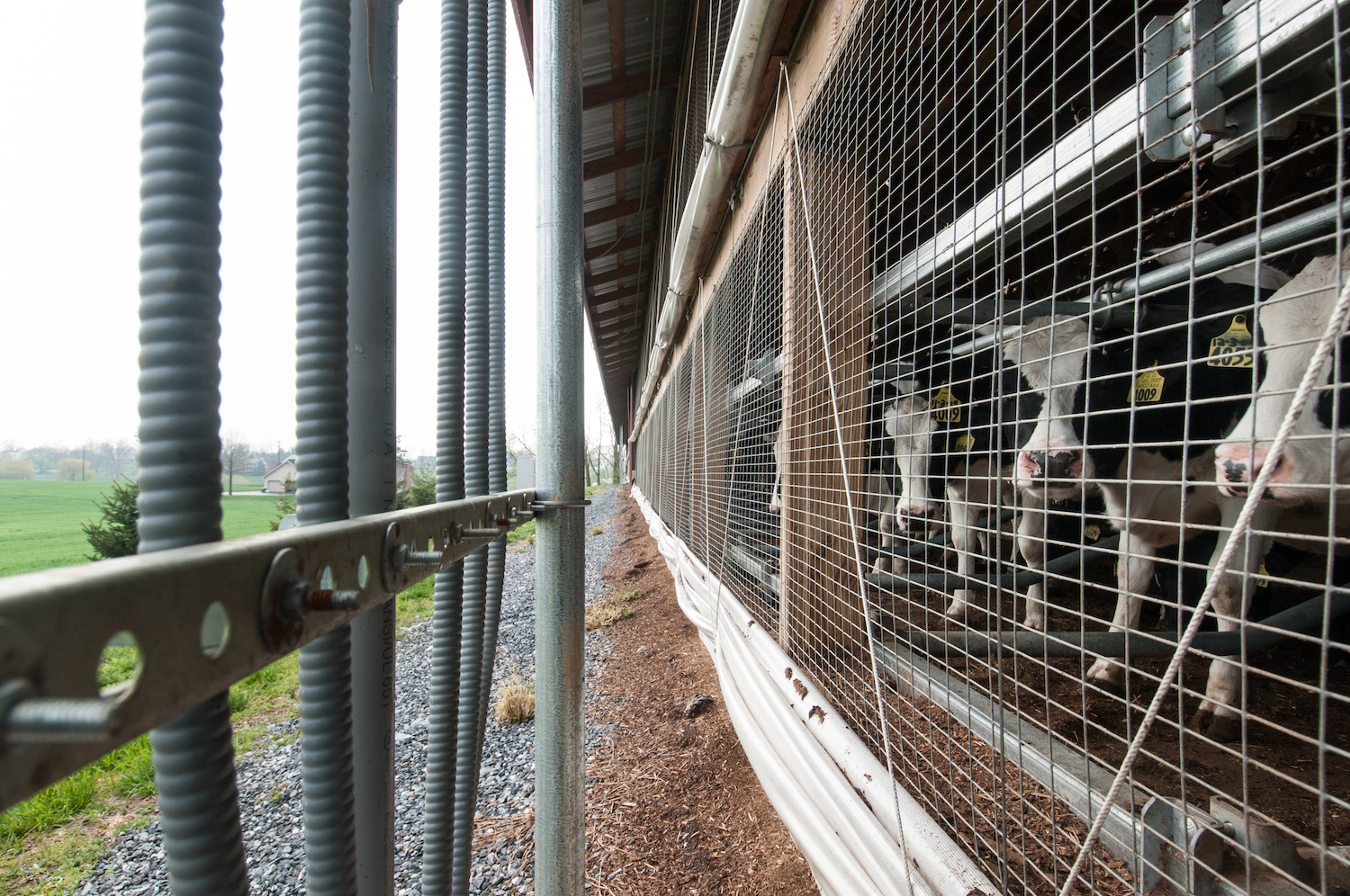
Some advocates believe the government is greenwashing and subsidizing factory farming at the expense of environmentally friendly producers
Phippen observes that sustainable, pasture-based dairies don’t make a lot of money for the larger agricultural industry—the feed producers and the antibiotics producers and the chemical companies and the anaerobic digester designers—which could explain the lack of investment in pasture-based systems that are better for the environment as a whole.
“I totally agree with soil health, and that might be a great thing,” says Phippen. “But who makes money off of that?”
***
Anaerobic digesters have received little critical coverage from the press. Local news outlets readily promote the “Save the farm, save the environment” storyline, and even national outlets uncritically describe biogas and methane as “renewable” or even “clean” energy sources. Just this weekend, NPR and PBS Newshour teamed up to report on the benefits of waste-to-energy systems on dairy farms.
Meanwhile, federal and state subsidies are creating perverse incentives for more and bigger factory farms: A Food & Water Watch report from earlier this year pointed out that, “multinational meat giant Smithfield Foods not only plans to push the U.S. factory farms that raise their animals to construct digesters, but also intends on building new factory farms specifically to tap into the potential to generate biogas.”
“The money being funneled into digesters is waste capital that should instead be invested in zero-emission renewable energy sources, like solar and wind.”
These perverse problems aren’t limited to the United States. Europe has wholeheartedly embraced biogas from anaerobic digesters as a “green” energy, but because processing poop alone doesn’t produce as much usable biogas as a mix of manure and food waste, some farmers have begun growing corn for the sole purpose of feeding digesters. As George Monbiot reported for The Guardian, that has been an environmental catastrophe, damaging soils and “threaten[ing] the fertility of the land, the health of our freshwater ecosystems and the homes at risk from flooding.”
“Biogas digesters are a false solution that do nothing to actually mitigate emissions from agriculture,” the Food & Water Watch report states. “On-farm digesters can cost anywhere from an estimated $400,000 to $5 million to construct depending on the size, design, and features. The money being funneled into digesters is waste capital that should instead be invested in zero-emission renewable energy sources, like solar and wind.”
Although the current administration isn’t known for loving renewable energy projects, the money is still flowing. As recently as July 2019, the USDA advertised a whopping $400 million in funding for renewable energy and energy efficiency projects for farms and other rural small businesses, which includes anaerobic digester projects. In New York, the $26 million that NYSERDA invested went to just 22 digesters—an enormous average per-project amount. And some of those operators could still get even more: Of the additional $16 million in funding that NYSERDA has announced, at least half is earmarked for refurbishing existing digesters.
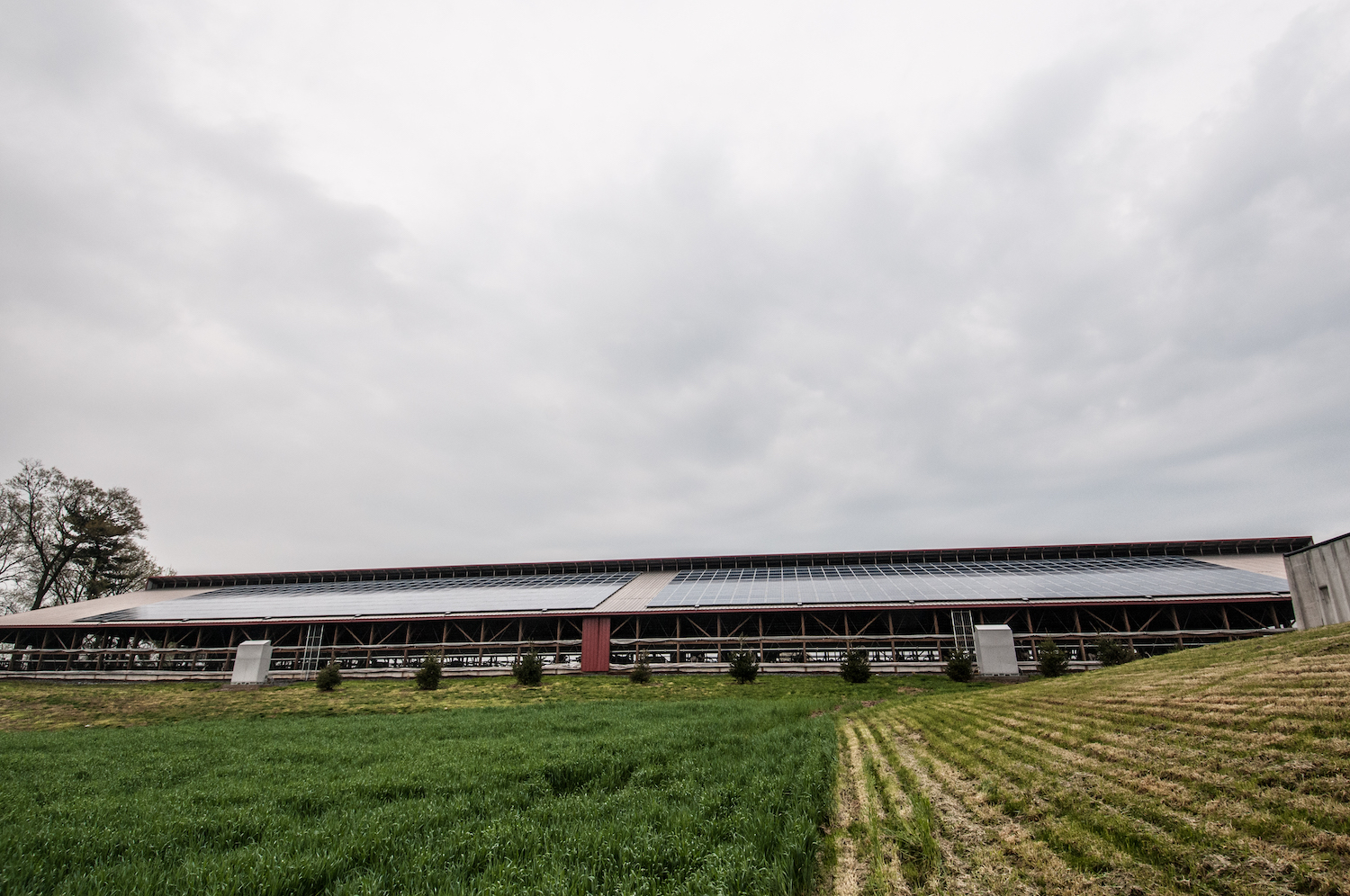
As recently as this July, the USDA has advertised a whopping $400 million to support projects like anaerobic digesters
“It’s a ton of money,” says Patty Lovera, food and water program director at Food & Water Watch. “And if that money is available from federal programs or state programs, let’s use that money for something better, to improve either renewable energy or farming practices.”
“This so-called solution, you know, further entrenches and subsidizes that corporate-controlled system,” says Newell. “We should be subsidizing family farmers who are doing the kinds of climate practices that benefit rural communities, financially and environmentally, and that put us on a path to where animal agriculture and agriculture in general is more regenerative and resilient and less extractive and exploitative.”
***
“[Dairy farmers] would always laugh and say, if manure ever became a problem, you were just too big for your britches.”
The appeal of anaerobic digesters is in their simplicity: power from poop, energy from waste. But this framing is misleading—energy production was always a byproduct, never the primary goal. (If energy production was the main incentive, one might expect the companies building, installing, and operating digesters to have done a better job eliminating inefficiencies, like the need to flare off excessive biogas.) Unfortunately, as a solution for manure management, anaerobic digesters are hardly a simple or complete solution, but rather one step in an insufficient and fallible process.
When it comes down to it, the problem is not really manure, because manure is a problem only in vast amounts.
“When I was growing up my neighbors were all dairy farmers,” says Peck. “And they would always laugh and say, if manure ever became a problem, you were just too big for your britches.”
The simplest solution is obviously to not amass manure in such large quantities—but that would require a complete reversal of assumptions about market consolidation and economies of scale. On the other hand, current milk production often exceeds demand, so maybe scale isn’t what is most needed right now, especially when mass production is strongly correlated with greater greenhouse gas emissions.
Taking steps to slow or reverse the consolidation of dairies and to encourage pasture-based farming could help curb air pollution that contributes to climate change. Instead, state and federal agencies are spending many millions on making giant factory farms that are too big for their britches marginally better for the environment, and calling it “green.”
Or at least, green enough.
“Nothing’s perfect. There isn’t a perfect solution for anything, and nobody in this world is perfect,” says Gooch. For supporters, anaerobic digesters may simply be the best farm waste solution we have—for now.
